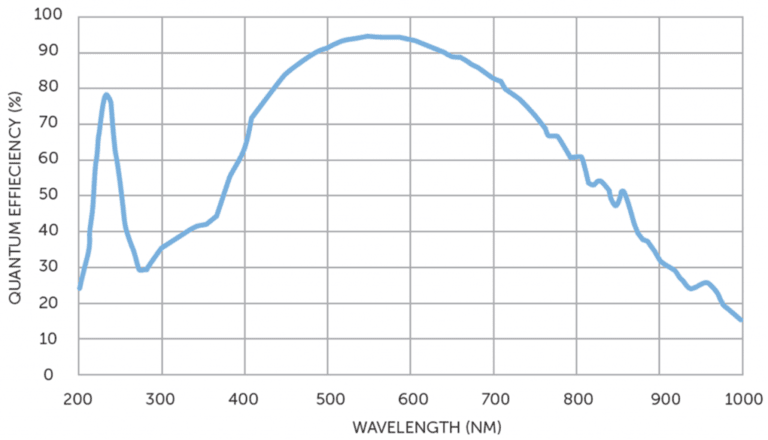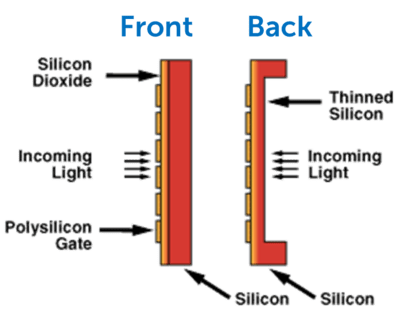Quantum Efficiency
Introduction
Quantum efficiency (QE) is the measure of the effectiveness of an imaging device to convert incident photons into electrons. For example, if a sensor had a QE of 100% and was exposed to 100 photons, it would produce 100 electrons of signal.
In practice, sensors are never 100% efficient, and different sensor technologies have different QE values. The highest‑end scientific cameras can achieve up to 95% QE but this is dependent on the wavelength of light being detected, as seen in Figure 1.

Figure 1: The quantum efficiency (QE) of a 95% quantum efficient sensor at different photon wavelengths.
95% QE is possible at 500-600 nm wavelengths (green/yellow) but it is less efficient at shorter
(violet, 300-400 nm) and longer (infrared, 800‑1000 nm) wavelengths.
This particular sensor also has a peak in QE at near-UV wavelengths, around 220-250 nm.
95% QE is possible at certain photon wavelengths but photons in the near-red and violet regions of the visible spectrum have a lower QE and therefore the scientific camera would be less sensitive. This is an especially important property when doing low-light imaging.
Silicon Properties
Most scientific camera sensors are made from silicon, so it is useful to examine the properties of this element and the way that it interacts with light.
In the high-purity crystalline form, each atom of silicon is covalently bonded to its neighbor. Energy greater than the band gap energy, about 1.1 eV, is required to break a bond and create an electron/hole pair. The wavelength of incoming light and photon absorption depth are directly related; the shorter the wavelength, the shorter the penetration depth into the silicon.
Front- and Back-Illumination
On a front-illuminated device, light typically enters the sensor through the gates of the parallel register. These gates are made of very thin polysilicon, which is reasonably transparent at long wavelengths but becomes opaque at wavelengths shorter than 400 nm. Thus, at short wavelengths ~400 nm, quantum efficiencies quickly drop off.
However, it is possible to uniformly thin a sensor and focus an image on the backside where there is no gate structure or microlenses. Because of this, back-illuminated devices exhibit high sensitivity to light and make it possible to increase quantum efficiencies up to 95%, as well as increasing sensitivity at short wavelengths ~400 nm.

Further Reading
Back To Camera Basics
Contact Us